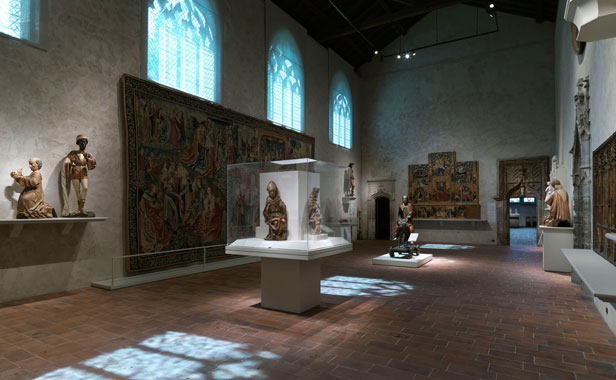An Algorithm for Preserving Art

Paolo Dionisi Vici’s life’s work is preserving aging art made from wood. He gets misty-eyed encountering rare artifacts from his hometown in Tuscany. He looks strikingly like Frank Zappa.
In other words, Dionisi Vici seems an unlikely person to get excited about the wireless sensors that are typically used to monitor the temperature of busy computers packed into IBM data servers.
But that’s exactly what he was excited about on April 6 in the busy halls of the Cloisters, the Metropolitan Museum of Art’s upper Manhattan branch, which contains some 3,000 medieval works.
With technical assistance from IBM, Dionisi Vici, an associate research scientist for the Met, has deployed 120 low-power temperature and humidity sensors there since June of last year in his quest to determine the ideal environmental conditions for priceless wood works.
The project could provide better models for art conservators, who have historically relied on intuitive observations and more generalized, slower measurements to prevent cracking, warping, and mold. One day it could provide a model for maintaining the Mona Lisa, which has an infamous 11-centimeter crack through its poplar wood panel. Dionisi Vici has been among the few who have had access to the painting to study its condition.
Currently, most artwork at the Cloisters is kept at a standard range around 70 °F and 50 percent humidity, but Dionisi Vici’s goal is to arrive at more nuanced formulas based on how individual works react to changing conditions.
Right now, he’s in his lab looking at old scrap wood. His long-term plan is to use real-time sensor data combined with a gauge of the art’s response, such as if the wood swells in certain conditions, to improve art conservation. After all, with visitors moving in and out the building’s open courtyards, climate control is not always easy.
“The idea is to see how right is the climate for a certain object. My real dream would be to have a system where the parameters we adopt are based on the real sensitivity of the objects,” says Dionisi Vici.
Those findings could one day program a self-controlling heating and cooling system that responds to climate fluctuations measured by the sensors, he says.
His search for the perfect climate is enabled by inexpensive sensors scattered unobtrusively about the Cloisters’ high-ceilinged rooms.
The sensors collect temperature and humidity data once per minute and use radio frequencies to transmit it back to a router that sends the data to IBM’s cloud servers. The result is a nuanced, 3-D building temperature and humidity map that both Dionisi Vici and the museum’s maintenance engineers can view from their desks. The low-power microcontroller has an expected five-year battery life.

That medieval paintings are speaking data to a wood scientist is one example of how low-cost, miniaturized computer chips and wireless technology can enable physical objects to communicate with other computers and devices over the internet—what’s often called the “Internet of things.”
IBM first used these sensors to drive down energy use in information technology and telecommunications infrastructure. David Bartlett, vice president of industry solutions with IBM’s Smarter Buildings program, says the company is now deploying its low-power “motes” in less obvious environments, including museums, hospitals, and college campuses. In other cases, engineers are using advanced sensors to monitor deteriorating bridges and highways.
The Cloisters has not yet connected the sensors to the building’s heating and cooling system, which Dionisi Vici says would better embody IBM’s concept for smarter buildings, where software can be used to actually automate building operations.
Doing so could also save the Cloisters more energy. The main Metropolitan Museum of Art building, for example, is a big energy user in New York City because of its need to maintain a constant climate as visitors stream through. The pilot project may eventually expand to the Fifth Avenue facility.
Saving energy, however, could never be a main priority when centuries-old art is at stake, Dionisi Vici believes. So far, he says, the data at the Cloisters show that the museum staff does a good job of keeping the building in the required climate range, and the sensor system will help.
What he is ultimately after—what is every museum conservator’s dream—is art that can last forever, he says. “When we talk about art objects, they have such a long story behind them. It’s a sort of mechanical memory. There’s still so much to learn.”
Keep Reading
Most Popular
Large language models can do jaw-dropping things. But nobody knows exactly why.
And that's a problem. Figuring it out is one of the biggest scientific puzzles of our time and a crucial step towards controlling more powerful future models.
How scientists traced a mysterious covid case back to six toilets
When wastewater surveillance turns into a hunt for a single infected individual, the ethics get tricky.
The problem with plug-in hybrids? Their drivers.
Plug-in hybrids are often sold as a transition to EVs, but new data from Europe shows we’re still underestimating the emissions they produce.
Google DeepMind’s new generative model makes Super Mario–like games from scratch
Genie learns how to control games by watching hours and hours of video. It could help train next-gen robots too.
Stay connected
Get the latest updates from
MIT Technology Review
Discover special offers, top stories, upcoming events, and more.